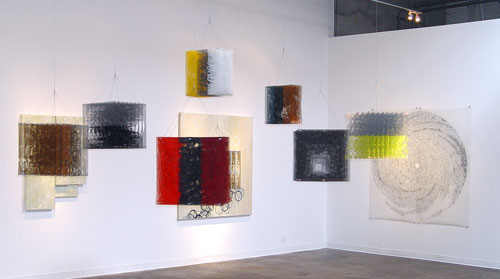Kotara’s new exhibit is ‘Secondary’ to none
When thinking of artwork, grids and science, structure and geometry might not necessarily be a person’s first thoughts. At first, they weren’t for local artist Kenn Kotara either.
“My background is really in classical drawing,” Kotara said. “I can draw you realistically. And I reveled in that. I reveled in the ability to be able to copy something. But I soon realized, to me, that was just copying something. I wanted to look into my own grey matter and see what I may be able to extract and extrapolate on. It evolved into adding abstraction” to his formerly photorealistic art.
“And adding abstraction became more conceptual,” he continued.”It’s more of my own ideas, instead of looking at something and copying it.”
Kotara’s unique mixed media artwork will be on display for the month of April at the brand-new London District Studios, which opened near Biltmore Village in March. This showing is a special treat for Asheville, as, while Kotara lives and works in the region, most of his shows and work are held or shipped out of state.
Drawing his creativity from a somewhat unusual place, Kotara talks about “the grid.” The grid is less about what’s off the grid and more about what’s on — or being connected by — it.
“The grid has always been prominent within the underlying structure and foundation,” he said. Think urban planning — “the way our streets are laid out. Oftentimes 90 degrees is much easier to deal with, but that’s only the starting point. And that’s what I was thinking about for the title of this show. The grid is the primary impetus for the work. Everything that’s secondary comes in afterthought — how I connect to those grids. I found that those strict parameters still allow for a great amount of creativity. I like the idea of starting with a very basic, closed-off system and opening it up to the possibilities.”
While living in Texas, Kotara would leave his home in the city and drive far out into the country — looking for shapes and colors that stood out from the grid.
“I would look at landscapes, and I would enjoy the way that farmers not only would fence off some of their properties but the way they would lay out the crops. They’d be creating these shapes and forms, and, if I had a decent enough vantage point, I’d use those forms to create the abstraction.”
It’s all about the way we, as humans, see and interact with the world. “Nature and human nature — the yin and yang,” he said.
But aside from picking up the abstract in the concrete, Kotara has also been experimenting with Braille to connect on more than just a visual level.
“Braille is a geometry; they’re circles,” Kotara pointed out. “I attempted to incorporate them for a different reason, and realized that I ended up loving that haptic, that touch, that sensory component as a language itself.”
Kotara takes excerpts from the works of important figures — Thomas Jefferson, Abraham Lincoln, Henry David Thoreau — and translates that into Braille to create a compelling, tactile work that’s more than just paint on canvas.
And some of his latest works take it one step further: “I’m sort of redacting Braille,” he explained. “Braille on a white background, covering certain things with black paint.”
These pieces of the text may, visually, be censored. But, for those who read by touch, the words are still there. “So what does that mean for us?” Kotara asked. “Do we still recognize that as a redacted document? Oftentimes that’s what really strikes us” — the black rectangular boxes shielding the public’s eyes.
Not everyone “gets” abstract art, and Kotara said he’s OK with that. “You see an abstract piece of artwork and (you) say, ‘What in the hell is this?'” Kotara explained. But, as an artist, he said he finds a lot of joy in the different ways people interpret his art — “it becomes something else, entirely different,” he said. “Some people find a rusty truck door beautiful and they want to hang it on their wall. It isn’t just because it’s a door. It’s the emotional ties, this family member, this old story, this narrative that’s a thread in each and every one of us.”
IF YOU GO
What: Opening reception for Kenn Kotara’s “Secondary” exhibit
Where: London District Studios, 8 London Road, Asheville
When: Friday, April 8, beginning at 5 p.m.

